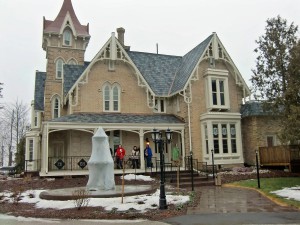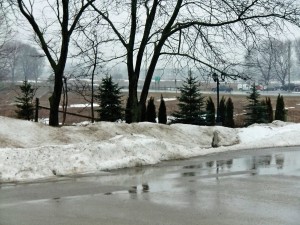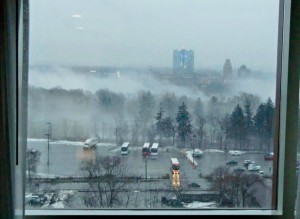IN SEARCH OF SNOW – BOUND FOR NIAGARA
IN SEARCH OF SNOW
This is the seventh in a series of articles about traveling by rail in search of snow
BOUND FOR NIAGARA
By Charles N. Stevens
Photos by Dolores Seidman
Another gray and rainy sky dulls the morning in Dearborn, Michigan. Only a few melting patches of snow remain, the green lawn outside our window now completely visible. Drops hang like jewels from the bare twigs of the trees, and people walk briskly outside with raised umbrellas.
After a sumptuous breakfast we board the bus bound for the Canadian side of Niagara Falls. We catch glimpses of Detroit’s skyline muted with fog and drizzle, the tops of the higher buildings swallowed by clouds. Using the Ambassador Bridge we coast into Windsor, Ontario Canada where the border guards check our passport, Canada’s maple leaf flag barely rippling. Their snow has disappeared too, the streets slick with rain.
We roll by the University of Windsor and then the Detroit River (They call it St. Claire) where a few chunks of ice float in the current. We pass the Hiram Walker Distillery and the vast Chrysler plant. Then we take Highway 401 east that leads us through flat farmland where ponds and puddles accumulate in the saturated soil. The temperature is a chilly 35 degrees. Near Chatham rainwater flows in the furrows of the fields, and the headlights of approaching cars seem to materialize out of the mist. They hiss in the wet as they pass, our windshield wipers sweeping in their squeaky rhythm.
Stopping near Ingersoll, Ontario, we have lunch at the Elmhurst Inn and Spa, the former estate of a man who pioneered cheese-making in the area and raised apples. It is good to get out of the chill moistness of the day and enter the coziness of the inn. Other tour groups are here also, the babble of voices blending with the rattle of plates and silverware. A piping hot bowl of chicken vegetable soup warms our insides and haddock with roasted potatoes is just right. I top my meal off with lemon meringue pie.
On our way again, we dash through open country, the trees in the distance dissolved in rain. As we proceed eastward, we encounter more snow patches, a ground fog hovering over them. On our right is the Grand River and bordering it is the town of Brantford. Just outside of it is the farm and laboratories of Alexander Graham Bell who developed the telephone in conjunction with his studies in helping the deaf. His mother and wife were both deaf.
Our bus leaves the 401 and turns on to the Wayne Gretsky Highway (403) east. Wayne Gretsky (The Great One), born in Brantford, a hero in Canada’s best loved sport, ice hockey, also played for the Los Angeles Kings. We get our first glimpse of blue-gray Lake Ontario then the canal that connects it to Lake Erie, closed in winter due to ice. We pass close to Niagara-on-the-Lake, home of the famous Shaw Festival.
At dusk we roll into the city of Niagara Falls and our lodging at the Doubletree Hotel. Fortunately we are given a room high up on the twelfth floor of the hotel facing the falls, giving us a partial view of the falls, the gorge of the river and part of the town. The spray from the falls creates a cloud that drifts for at least a mile up the river then spills over the sides. The sight of it drifting down the river is quite magical in the dim light of early evening. The trees along the edge of the gorge are nearly hidden in thick fog.
The Skylon with its Falls View Restaurant high atop it twinkles in the increasing darkness, the ever present rain still falling lightly. Across the way is the Seneca-Niagara Casino with moving colored lights down its face replicating the action of the falls. The Niagara Skywheel, a gigantic Ferris wheel turns while blinking and flashing its lights, the fog from the falls sometimes hiding part of it. But these are the frills of the area and are pale compared to the grandeur of the falls and the cloud that creeps down the river.

We stop at the Elmhurst Inn at Ingersoll, Ontario, Canada for a delicious lunch.

Outside the Elmhurst Inn the day is rainy and wintery.

From our hotel window at Niagara Falls we have a beautiful view of the city and the cloud from the falls.

A hazy picture of the clouds churned up by the spray of Niagara Falls.
MONTEREY PARK AUTHOR PUBLISHES 3RD BOOK ABOUT HIS EXPERIENCES IN WORLD WAR II- BACK FROM COMBAT
Charles “Norm” Stevens, a 40 year resident of Monterey Park and World War II Veteran has recently published the 3rd in his series about his experiences in WW II, Back from Combat: A WWII Bombardier Faces His Military Future. This book details the time from when he returned from combat in England where he flew 34 missions over Germany and France until the end of the war. Faced with large numbers of returning combat vets, and not knowing how long the war would continue, the military had to plan for their future. His options were whether to return to combat, become an instructor in the U.S., or receive new training that he would use in the Pacific. The book concludes with the end of the war with an Afterward that includes an update on the B-l7’s still flying in the U.S., as well as present day accounts pertaining to the war.
Stevens is the author of two previous books about his experiences:
An Innocent at Polebrook: A Memoir of an 8th Air Force Bombardier (Story of his 34 bombing missions from his base at Polebrook, England over Germany and France)
The Innocent Cadet: Becoming A World War II Bombardier (A prequel to the first, telling of his training in the U.S. before going overseas into combat.)
He is known to the readers of The Citizen’s Voice as the author of Travel Log Articles including “From Paris to Normandy on the Seine”, “Exploring New York” and “In Search of Snow.” He is retired, having taught for 32 years, primarily in the Montebello Unified School District.
Those interested in purchasing an autographed copy of any of his books, may contact the author at 323-721-8230 or Normstevens24@gmail.com.



